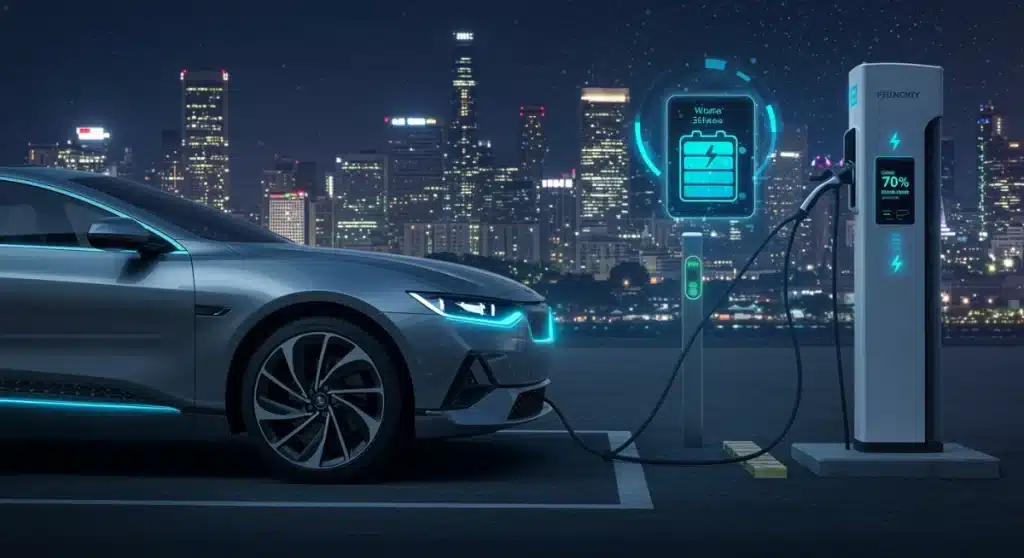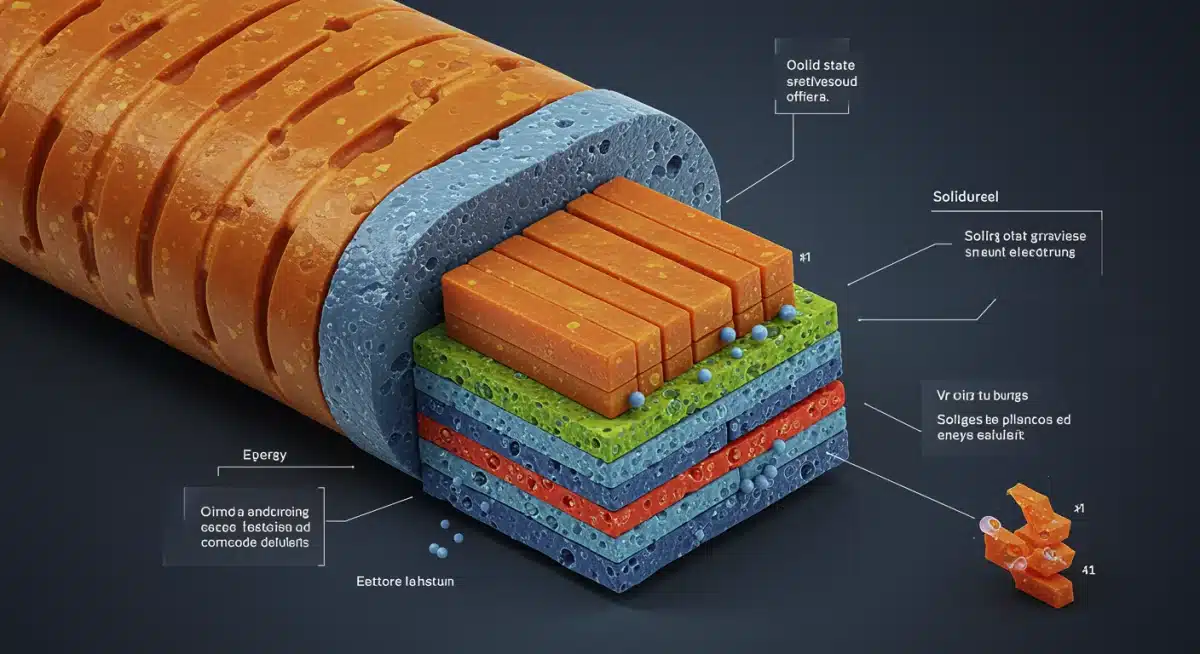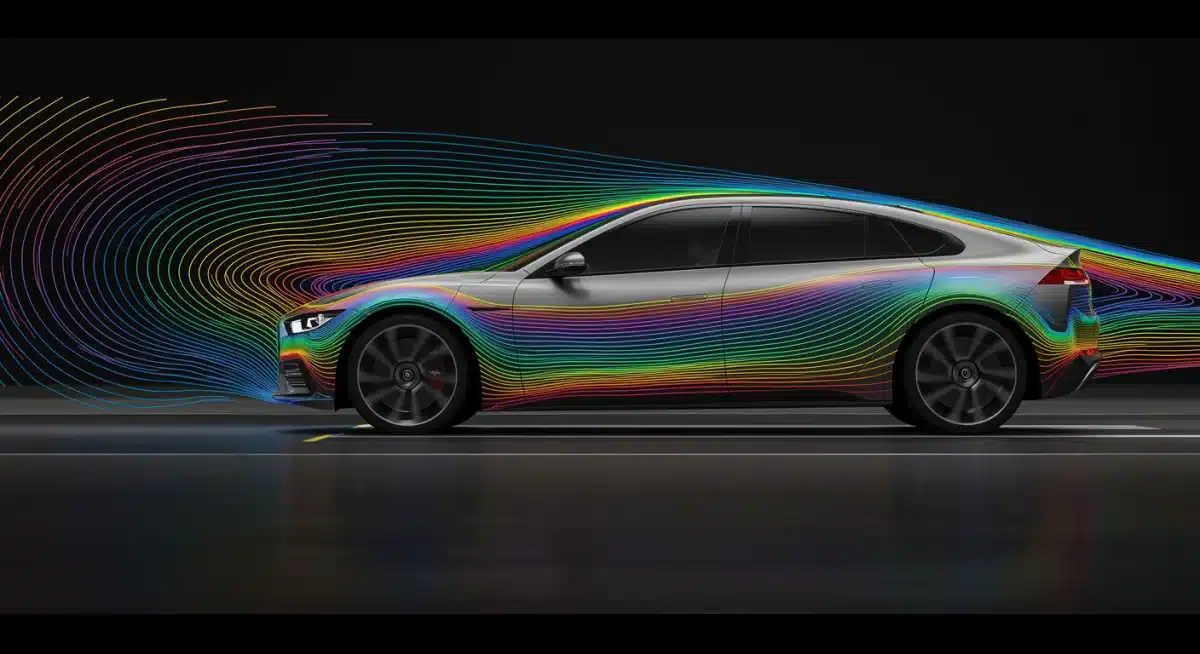EVs: 5 Tech Innovations Boosting Range 30% by 2025 for US Consumers

The future of electric vehicles is rapidly approaching, with five recent tech innovations poised to significantly boost EV range by 30% for US consumers by 2025, transforming the landscape of sustainable transportation.
The automotive world is at the cusp of a revolution, and at its heart lies the relentless pursuit of greater efficiency and endurance for battery-powered cars. When we talk about The Future of Electric Vehicles: 5 Recent Tech Innovations Driving 30% More Range for US Consumers by 2025, we’re discussing not just incremental improvements, but transformative shifts that will redefine what it means to own and drive an EV.
Next-Generation Battery Chemistry: Beyond Lithium-Ion
For years, lithium-ion batteries have been the workhorse of electric vehicles, offering a respectable balance of energy density and cost. However, the demand for longer ranges and faster charging times has pushed researchers to explore chemistries that transcend the limitations of current technology. The next generation of batteries promises a significant leap forward, making ‘range anxiety’ a relic of the past for many US consumers.
Innovations in battery chemistry are focusing on several key areas, each with the potential to unlock substantial gains in energy storage. These advancements are not just about packing more power into the same space; they’re also about improving safety, durability, and cost-effectiveness, all crucial factors for widespread EV adoption.
Solid-State Batteries: The Holy Grail of Energy Storage
Solid-state batteries are widely considered the holy grail of EV battery technology. Unlike traditional lithium-ion batteries that use liquid electrolytes, solid-state batteries employ solid materials, offering a host of advantages.
- Higher Energy Density: Solid electrolytes allow for more compact cell designs, meaning more energy can be stored in a smaller, lighter package. This directly translates to increased range.
- Enhanced Safety: The elimination of flammable liquid electrolytes significantly reduces the risk of thermal runaway and fires, a major safety concern for current EV batteries.
- Faster Charging: Early tests suggest solid-state batteries could charge much faster than their liquid-electrolyte counterparts, potentially reaching 80% capacity in under 15 minutes.
Several major automotive manufacturers and battery developers are heavily investing in solid-state technology, with prototypes already demonstrating impressive performance. While mass production faces challenges, the trajectory indicates these batteries could be a reality in production vehicles before 2025, contributing significantly to the 30% range increase target.
Silicon Anodes and Other Material Advancements
Beyond solid-state, other material innovations are enhancing existing lithium-ion structures. Silicon anodes, for instance, can store significantly more lithium ions than traditional graphite anodes, leading to higher energy density.
- Increased Capacity: Silicon’s theoretical capacity is nearly ten times that of graphite, offering a direct pathway to more energy storage per battery cell.
- Improved Performance: While silicon anodes face challenges like volume expansion during charging, ongoing research is mitigating these issues, making them viable for near-term adoption.
- Cost-Effectiveness: Integrating silicon into existing battery manufacturing processes can be more cost-effective than a complete overhaul, allowing for quicker implementation of range improvements.
These advancements in battery chemistry represent the foundational layer for achieving substantial range improvements. By leveraging new materials and designs, engineers are pushing the boundaries of what’s possible, ensuring that future EVs can travel further on a single charge.
Advanced Aerodynamics and Lightweight Materials
While battery technology often steals the spotlight, significant gains in EV range are also being realized through meticulous engineering in vehicle design. The principles of aerodynamics and lightweight construction are undergoing a renaissance, specifically tailored to the unique demands of electric powertrains. Reducing drag and shedding unnecessary weight are two of the most cost-effective ways to extend an EV’s range without needing a larger battery.
Every ounce saved and every bit of air resistance conquered directly translates into less energy required to move the vehicle. This holistic approach to efficiency is crucial for meeting the ambitious 30% range increase target and enhancing the overall driving experience for US consumers.
Sleeker Designs and Active Aero Components
Modern EVs are increasingly characterized by their sleek, minimalist designs, which are not just aesthetic choices but functional necessities. Designers are leveraging advanced computational fluid dynamics (CFD) to sculpt vehicles that cut through the air with minimal resistance.
- Optimized Body Shapes: Smooth underbodies, flush door handles, and integrated spoilers are becoming standard, reducing turbulence and drag.
- Active Grille Shutters: These automatically open or close to manage airflow, reducing drag at higher speeds and improving cooling when needed.
- Aerodynamic Wheels: Specialized wheel designs minimize air resistance, often featuring covers or unique spoke patterns that guide airflow efficiently.
These seemingly small design details collectively make a substantial difference. Manufacturers are pushing the boundaries of traditional car design, creating vehicles that are as much about efficiency as they are about style. The synergy between design and engineering is paramount in achieving superior aerodynamic performance, directly contributing to extended range.
Revolutionizing Vehicle Construction with Lightweight Composites
The quest for efficiency also extends to the very materials used in vehicle construction. Traditional steel and aluminum are being supplemented, and in some cases replaced, by advanced lightweight materials. These materials offer comparable strength with significantly reduced mass, directly impacting energy consumption.

- Carbon Fiber Composites: Once exclusive to high-performance sports cars, carbon fiber is becoming more accessible, offering exceptional strength-to-weight ratios for structural components.
- Advanced High-Strength Steels: Even traditional materials are evolving, with new alloys providing greater strength at thinner gauges, reducing overall vehicle weight.
- Multi-Material Architectures: Engineers are strategically combining different materials, placing them where they offer the most benefit in terms of weight reduction and structural integrity.
By making vehicles lighter, less energy is needed to accelerate and maintain speed, directly improving range. These advancements in materials science are not just about reducing weight; they’re about creating safer, more durable, and ultimately more efficient electric vehicles for the modern consumer.
Enhanced Powertrain Efficiency and Thermal Management
Beyond the battery and the vehicle’s external shell, the internal workings of an EV’s powertrain are also undergoing significant innovation. Maximizing the efficiency of electric motors and optimizing how heat is managed within the system are critical for squeezing every possible mile out of a charge. Even small percentage gains in these areas can accumulate into substantial range increases.
Engineers are focusing on integrating components more effectively and developing smarter systems that can adapt to various driving conditions, ensuring that power is used as efficiently as possible. This meticulous attention to detail in the powertrain is a cornerstone of achieving the 30% range enhancement for US consumers.
More Efficient Electric Motors and Inverters
The electric motor is the heart of an EV, converting electrical energy into mechanical motion. Recent advancements are making these motors smaller, lighter, and more efficient than ever before.
- Permanent Magnet Synchronous Motors (PMSM): These motors are becoming more refined, offering higher power density and efficiency across a wider range of operating speeds.
- Silicon Carbide (SiC) Inverters: Replacing traditional silicon, SiC power electronics significantly reduce energy losses during power conversion, leading to greater overall system efficiency.
- Axial Flux Motors: Emerging designs are exploring axial flux motors, which can offer higher torque density and efficiency in a more compact package, ideal for space-constrained EVs.
These motor and inverter improvements mean that less energy is wasted as heat or electrical resistance, directly translating into more miles per charge. The continuous refinement of these core components is a quiet but powerful driver of EV range expansion.
Sophisticated Thermal Management Systems
Batteries and electric motors generate heat, and managing this heat effectively is crucial for both performance and longevity. An optimized thermal management system can ensure components operate at their ideal temperatures, improving efficiency and preventing degradation.
- Integrated Cooling Loops: Modern EVs use sophisticated liquid cooling systems that manage temperatures for the battery, motor, and power electronics, often with shared loops for greater efficiency.
- Heat Pumps: These systems can efficiently heat and cool the cabin by transferring heat rather than generating it, significantly reducing the energy drain on the battery, especially in extreme climates.
- Pre-conditioning: Smart systems can pre-condition the battery to its optimal operating temperature before charging or driving, maximizing charging speed and efficiency from the start of a journey.
By intelligently controlling temperatures, these systems not only extend the lifespan of critical components but also ensure that the battery can deliver its full potential, contributing directly to an extended driving range. Thermal management is an unsung hero in the quest for greater EV efficiency.
Smart Software and Predictive Range Management
Hardware improvements are only part of the equation; the intelligence that governs an EV’s operation plays an equally vital role in maximizing range. Advanced software, combined with sophisticated sensors and predictive algorithms, is transforming how electric vehicles manage their energy. This means not just knowing how far you can go, but optimizing how you get there.
These software innovations offer a dynamic approach to range management, adapting to real-world conditions and driver behavior. For US consumers, this translates into more reliable range estimates and a more confident driving experience, directly contributing to the ambitious 30% range increase by 2025.
AI-Powered Route Optimization and Energy Prediction
Modern EV navigation systems are far more than simple map tools. They integrate a wealth of data to provide highly accurate range predictions and optimize routes for energy efficiency.
- Real-time Traffic and Weather: Algorithms adjust range estimates based on current traffic conditions, speed limits, and even adverse weather, which can significantly impact energy consumption.
- Topography and Elevation: Routes are analyzed for hills and inclines, with the system predicting how much energy will be consumed climbing and how much can be regenerated descending.
- Driver Behavior Learning: Some systems learn individual driving styles, providing personalized range predictions that become more accurate over time.
This predictive capability helps drivers plan their journeys more effectively, reducing anxiety about running out of charge. By suggesting the most energy-efficient routes, these systems actively contribute to extending the practical range of an EV.
Over-the-Air Updates and Continuous Improvement
Just like smartphones, modern EVs are designed to evolve and improve over time through over-the-air (OTA) software updates. This capability allows manufacturers to continuously refine energy management algorithms and introduce new efficiency features long after a vehicle has left the factory.

- Firmware Optimizations: OTA updates can improve the efficiency of the motor, inverter, and battery management system, leading to small but cumulatively significant range gains.
- New Driving Modes: Manufacturers can introduce new eco-driving modes or refine existing ones, offering drivers more options to conserve energy.
- Diagnostic Improvements: Better diagnostics help identify and address potential inefficiencies, ensuring the vehicle operates at peak performance.
The ability to continuously enhance an EV’s efficiency through software updates means that vehicles can actually become better over their lifespan, further contributing to the overall goal of extended range without physical modifications. This dynamic improvement mechanism is a powerful tool in the EV revolution.
Advanced Charging Infrastructure and Bidirectional Capabilities
While not directly increasing the physical range of an EV, advancements in charging infrastructure significantly enhance the practical usability and perceived range for consumers. Faster, more accessible charging points reduce the time spent replenishing power, making longer journeys more feasible and less stressful. The focus is not just on speed, but also on smart integration with the grid.
Furthermore, bidirectional charging opens up new possibilities for energy management, turning EVs into mobile power banks. These innovations are crucial for making electric vehicles a seamless part of daily life and for achieving the broader goal of making EVs more attractive to US consumers.
Ultra-Fast Charging Networks
The proliferation of ultra-fast DC charging stations is rapidly diminishing the time required to recharge an EV. These chargers, capable of delivering hundreds of kilowatts, can add significant miles in very short periods.
- Higher Power Output: Chargers are moving beyond 150 kW to 350 kW and even higher, allowing for 80% charge in 15-20 minutes for compatible vehicles.
- Expanded Network: Government incentives and private investments are accelerating the rollout of these high-speed chargers along major highways and in urban centers across the US.
- Standardization: Efforts to standardize charging connectors (like CCS) are improving interoperability, making it easier for all EV owners to access fast charging.
The convenience of rapid charging reduces the effective ‘downtime’ associated with EVs, making them more competitive with gasoline-powered cars for long-distance travel. This expansion and acceleration of charging infrastructure are vital for reducing range anxiety and boosting consumer confidence.
Bidirectional Charging (V2G/V2H)
Bidirectional charging, or Vehicle-to-Grid (V2G) and Vehicle-to-Home (V2H) technology, allows EVs to not only draw power from the grid but also feed power back into it or to a home. This transforms the EV from a mere consumer of electricity into an active participant in energy management.
- Grid Stability: EVs can help stabilize the grid by providing power during peak demand or storing excess renewable energy.
- Home Backup Power: In the event of a power outage, an EV can power a home for several days, offering significant resilience.
- Revenue Generation: Owners could potentially earn money by selling excess energy back to the grid during high-demand periods.
While still in early stages of deployment, bidirectional charging has the potential to add immense value to EV ownership, making them more than just transportation. This innovation enhances the utility and economic benefits of EVs, making them a more compelling choice for US consumers.
Regenerative Braking Optimization and Energy Harvesting
Harnessing energy that would otherwise be lost is a cornerstone of EV efficiency. Regenerative braking, while not new, is continually being refined to capture more energy more effectively. Beyond braking, new methods of energy harvesting are also being explored, aiming to convert various forms of waste energy into usable electricity to extend range.
These technologies are crucial for maximizing the energy budget of an EV, especially in urban driving conditions where frequent stopping and starting occur. Every watt-hour recovered contributes to the overall range, pushing towards and beyond the 30% increase target for US consumers by 2025.
Advanced Regenerative Braking Systems
Modern regenerative braking systems are becoming increasingly sophisticated, recovering a greater percentage of kinetic energy during deceleration and braking. This energy is then fed back into the battery, effectively extending the vehicle’s range.
- One-Pedal Driving: Many EVs now offer a strong regenerative braking mode that allows for most driving to be done using only the accelerator pedal, maximizing energy recovery.
- Predictive Regeneration: Systems are integrating with navigation and sensor data to predict braking needs, optimizing regeneration based on upcoming traffic or topography.
- Blended Braking: Seamless integration between regenerative and friction braking ensures optimal energy recovery while maintaining consistent braking feel and safety.
These advancements make regenerative braking not just an efficiency feature, but an integral part of the driving experience, actively contributing to a longer range and a more engaging ride. The continuous development in this area ensures that less energy is wasted, directly benefiting the EV’s overall efficiency.
Emerging Energy Harvesting Technologies
Beyond braking, researchers are exploring other innovative ways to harvest energy from the vehicle’s environment or its own operation. While still largely experimental, these technologies hold promise for future range extensions.
- Solar Integration: While current solar panels on EVs offer modest gains, advancements in photovoltaic efficiency and integration are making them more viable for supplementary charging.
- Suspension Energy Harvesting: Systems that convert the kinetic energy from suspension movement (e.g., driving over bumps) into electricity are being developed, though their impact on overall range is yet to be significant.
- Thermoelectric Generators: Converting waste heat from various vehicle components into electricity is another area of research, aiming to reclaim energy that would otherwise dissipate.
While these emerging technologies may not deliver massive range increases individually, their combined effect, alongside optimized regenerative braking, could offer incremental but valuable extensions to an EV’s driving range. This multi-faceted approach to energy recovery underscores the comprehensive effort to maximize EV efficiency.
| Key Innovation | Range Impact |
|---|---|
| Solid-State Batteries | Higher energy density, safer, faster charging for significant range boosts. |
| Aerodynamic Design & Lightweight Materials | Reduced drag and vehicle mass directly increase efficiency and range. |
| Powertrain Efficiency & Thermal Management | Smarter motors, inverters, and cooling systems minimize energy waste. |
| Smart Software & Regenerative Braking | AI route optimization and enhanced energy recovery maximize usable range. |
Frequently Asked Questions About EV Range Innovations
Solid-state batteries use solid electrolytes instead of liquid ones, allowing for higher energy density, improved safety, and faster charging. This technology is crucial because it can dramatically increase how far an EV can travel on a single charge while also reducing fire risks and charge times.
By making EVs more aerodynamic, designers reduce air resistance, which means less energy is needed to move the vehicle. Similarly, using lightweight materials like carbon fiber reduces the car’s overall mass. Both factors directly lower energy consumption, allowing the battery to power the vehicle for longer distances.
Yes, absolutely. Over-the-air (OTA) software updates allow manufacturers to continuously optimize an EV’s energy management algorithms, refine powertrain efficiency, and introduce new eco-driving modes. These improvements, often implemented remotely, can lead to small but cumulatively significant gains in driving range over the vehicle’s lifespan.
Bidirectional charging enables an EV to not only draw power from the grid but also feed it back (Vehicle-to-Grid) or power a home (Vehicle-to-Home). This enhances EV utility by turning them into mobile energy storage units, capable of stabilizing the grid, providing home backup power, and potentially even generating revenue for owners.
Regenerative braking systems recover kinetic energy that would typically be lost as heat during deceleration or braking. They convert this energy back into electricity and store it in the battery. By efficiently recapturing this energy, especially in stop-and-go traffic, regenerative braking significantly extends the overall driving range of an electric vehicle.
Conclusion
The journey towards a more sustainable and efficient automotive future is accelerating, driven by remarkable technological advancements. The convergence of innovations in battery chemistry, aerodynamic design, powertrain efficiency, smart software, and charging infrastructure is poised to deliver a significant 30% increase in electric vehicle range for US consumers by 2025. These developments are not just about numbers; they represent a fundamental shift in how we perceive and interact with personal transportation, making EVs an increasingly practical, desirable, and indispensable part of our daily lives. As these technologies mature and become more integrated, the electric vehicle will not only overcome former limitations but emerge as the definitive standard for mobility.





